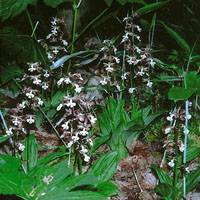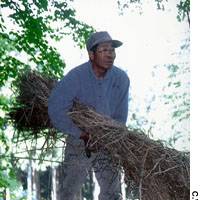I started to buy neglected woodland on a mountainside near where I live in Nagano Prefecture more than 20 years ago. Together with a local forester (and now long-time friend), Nobuyoshi Matsuki, we began tending the woods. One of the delightful results was the blooming of hundreds of wild Calanthe discolor orchids , which are known as ebine in Japanese.
These elegant plants grow 30 to 50 cm high, and in early June up here they bear very distinctive white or pale-pink flowers. This orchid was very common around Japan before it became popular as an ornamental plant, and thence a target for money-grubbing professional dealers and selfish amateur enthusiasts. The profusion that bloomed in our woods attracted a lot of people, and I was rather proud. Surely, I thought, this was a sign that we were doing something right.
However, the pleasure was not to last. One weekend, probably very early in the morning, people came with an all-terrain vehicle of some kind and uprooted every orchid they could find. We estimated that the black market value of their haul from our woods was about 5 million yen.
Mr. Matsuki said we shouldn't have told anybody, let alone shown the orchids off. I felt murderous. In the 15 or so years since that happened, small patches of the orchids have grown back, and we watch and nurture them. I have issued warnings all around that if this old red devil catches a poacher, he'll do evil things to him or them -- and to hell with the consequences! But, realistically, until we put up hidden surveillance cameras, we have only a small chance of catching them.
Thieves regularly steal various kinds of sansai (wild mountain vegetables) and other valuable plants, as well as mushrooms -- even the ones we've seeded onto logs. Not only that, but we pretty well have to mount sentries to guard young owls. (Thanks to the Harry Potter novels which started off a craze among Japanese office ladies for keeping owls as pets!) The thieves are local, and they watch when we are away. We've caught a few mushroom thieves, one of whom was a television director from a local station. His friend had been in our woods doing a documentary the week before, and had told him about the wealth of mushrooms.
It seems to never end, though, and just last week Mr. Matsuki told me that two species of rare flowers -- tegata chidori (Gymnadenia coposea) and nobine chidori (G. camtschatica) -- have vanished from our woods thanks to plant thieves.
Despite these setbacks, if you tend mixed woods properly, they become very productive. For example, we have had experts so far identify 301 species of mushrooms in our woods, and they estimate that the true total will be around 600. Many of these species have vanished from the rest of Nagano Prefecture. Some are valuable. We have also identified 343 species of plants, three of which are on the Nagano Red List (a list of endangered plants and creatures), and we believe that this will rise to 600. Last year we had confirmed sightings of 66 species of birds, of which 10 are on the Red List. We have bears, foxes, racoon dogs, hares, martens, weasels, squirrels, civet cats, dormice, moles and mice -- and we find monkey droppings and wild boar tracks, too.
We haven't got around to doing thorough research on our reptiles, but I've seen three kinds of snakes, three kinds of frogs, as well as toads, lizards and newts. As for insects, one expert reckoned that we'd have at least 700 species.
Summertime is my favorite season in our woods. It's when so much is happening, with plants growing and flowering, birds nesting and bears visiting. We are busy too. This year, Mr. Matsuki is rethatching his "tea hut" and the roof over the charcoal kiln.
Last year, after two years' assessment of a new parcel of land we had added to our woods, we decided to do some drastic work. We dug several small new ponds and a winding waterway, 480 meters long. Almost all the trees were dead, sick, or just of poor quality. The land had been badly abused, with holes dug here and there to extract iron-rich earth during the war, useless ditches that didn't work, and so on. We needed to lower the aquifer so that the trees' roots weren't drowning, and to provide lots of new habitat for water-loving creatures. We also had to convert the area into a place that would grow a mixture of flowering and fruit- or nut-bearing trees.
The new ponds and water course are already teeming with tadpoles, and some transplanted irises are growing well along their edges. Soon we'll also put in some reeds, rushes and a few patches of watercress and marsh marigolds (which already grow on older ponds on our land) -- all of which will attract more water life.
We planted several hundred saplings this spring, and we will plant a selection of water plants in the ponds and ditches. Meanwhile, we observe and record how other flora moves in.
Over these 20 years, our forestry efforts have been mostly to repair or heal the woods. On this patch, though, we have pretty well cleared the slate, leaving only a handful of trees that we think have a chance of growing and reproducing (elms, silver birch, magnolia). We have also replanted a dozen species, including mountain cherries, oaks, horse chestnut, maples, dogwoods, katsura and zelkova. When these trees flower and fruit, they will attract birds and animals -- which will in turn bring other species of plant seeds.
In the middle of one of the new shallow, boggy ponds -- which will be a great habitat for frogs and dragonflies -- we've built a little island. Mr. Matsuki replanted some ebine orchids there last autumn, and they are blooming nicely. If thieves come for them, we hope they get terminally stuck in the mud!
I really enjoy pottering around in woods and ponds, and every year the place gets more and more beautiful. (Three years ago, I donated this land to form a trust, so its growth and development can continue long after I've gone). The trouble is that this year I've had to spend a lot of time at the Aichi Expo, which is a long way from here. I also have to travel and talk about woodland-, forest- and river-restoration and conservation in towns all over the place . . . when I'd far rather just get on with doing it, here in Kurohime.
If I had my way, I'd camp out in the woods, with a big stick to hand in case any more plant poachers come. Bears are welcome. They only take what they need . . . and we share a love of honey.
Hear Ye! Hear Ye! Hear Ye!
Editor's note: Bashful as ever, perchance, and though not one to toot his own tuba, Old Nic nonetheless has plenty to be pleased about just now.
Yes, your Welsh-born JT columnist has got a gong. Which, in translation, means he has been awarded an Honorary MBE by Queen Elizabeth II in her 2005 Birthday Honours List. (An "honorary" Member of the British Empire, that is, because he is now a Japanese citizen.)
Asked quite what for, and Clive of that ilk feigns bafflement. It may, of course, be for his outstanding contribution to matters environmental on at least four continents, but especially in Japan and between Britain and Japan. It may be for his dozens of books, both fiction and non-fiction, that have delighted millions the world over. Or it may simply be for being too big, busy and boisterous a red-faced old bear for even HRH to ignore.
Whatever, Old Nic's investiture will be held at the British Embassy in Tokyo on Oct. 28. And he will be wearing kimono.
Congratulations, indeed, esteemed colleague!






















With your current subscription plan you can comment on stories. However, before writing your first comment, please create a display name in the Profile section of your subscriber account page.